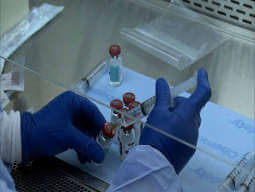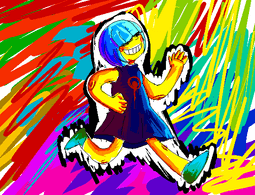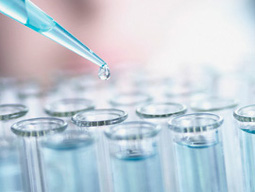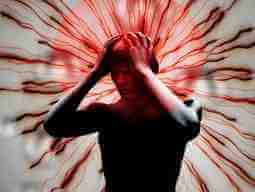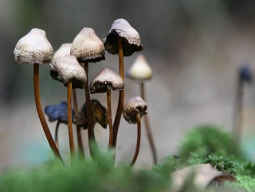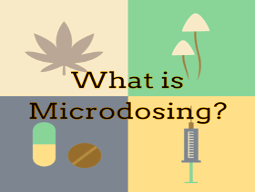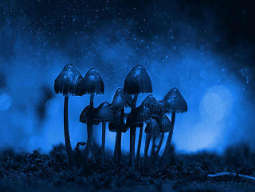Out of the Ergot fungus which grows on Rye, comes a psychedelic called LSD (lysergic acid diethylamide). LSD is most popularly known as the drug of choice during the 1960s counterculture.
The Swiss scientist Albert Hofmann, in 1938, developed LSD during his research on preventing post-partum bleeding, which was the leading killer of women during childbirth. It sat on his shelf for years, until he accidentally ingested a bit of LSD through his skin, and thus discovered the hallucinogenic properties of this drug.1
I suddenly became strangely inebriated. The external world became changed as in a dream. Objects appeared to gain in relief; they assumed unusual dimensions; and colors became more glowing. Even self-perception and the sense of time were changed. When the eyes were closed, colored pictures flashed past in a quickly changing kaleidoscope. After a few hours, the not unpleasant inebriation, which had been experienced while I was fully conscious, disappeared. what had caused this condition?
Buy a copy of LSD My Problem Child: Reflections on Sacred Drugs, Mysticism and Science from Amazon.
Or, read for free at the Psychedelic Library2
Since it was the twenty-fifth in a series of lysergamide derivatives, its official name became LSD-25.
LSD is an extremely powerful hallucinogen, and has immense potential for therapeutic, spiritual and cultural transformation.
LSD Facts
LSD is an amazingly powerful psychedelic; a favorite of many psychedelic explorers.
LSD promotes neuroplasticity and neural connection growth in the brain.3
There are a few key facts about LSD which are not very well known. Here are some important facts about LSD such as addiction potential, psychotherapeutic use, historical time line, and chemical moiety that everyone should know about.
-
LSD is one of the most powerful hallucinogenic drugs known to man. It requires only 100ug (smaller than a grain of salt) to produce profound psychological alteration.45
-
LSD was used by the US government for project MKUltra, also known as the CIA mind control program.
-
The duration of an LSD trip is between 6 and 12 hours. It takes about 30-60 minutes to come on, and another 30 minutes for the come up.6
-
LSD is not just a serotonergic agonist. This means that it not only targets the serotonin receptors as the neurotransmitter “serotonin” does; it is also a potent Dopamine D2 receptor agonist and a partial antagonist.7
-
Unlike its serotonergic agonism, which creates higher concentrations of 5-Hydroxy Tryptamine in the brain, LSD with its dopaminergic agonism does not increase dopamine concentrations in the brain, which makes LSD physically non-addictive. Dopamine controls the reward circuitry of the brain.8
-
LSD is chemically active at the microgram dosage, making it one of the most potent psychedelics available to man weight for weight. The only one compound stronger than LSD is Salvinorin-A, found in the Salvia Divinorum plant. Salvinorin-A is active at only 250ug and is often considered to produce a stronger exerience than DMT itself, one of the strongest hallucinogens known to man.
-
The only thing stronger than LSD, DMT, and Salvinorin-A is the newly developed Salvinorin-B Ethoxy-Methyl-Ether.9 Salvinorin-B is 10 times more potent than Salvinorin-A, making it around 10-15 times more potent than LSD.
-
Some of the most well-known philosophers, artists, and tech gurus like Steve Jobs, Cary Grant, John Lennon, Aldous Huxley, and George Harrison from the Beatles, the famous comedians Cheech Marin, Tommy Chong, and George Carlin have taken LSD.10
-
LSD, however, in some cases, has the potential to cause psychological issues - especially in people with psychosis, schizophrenia, or a family history of mental illness. LSD may actually exacerbate these conditions.11
What is LSD?
Lysergic Acid diethylamide is a medicine of extraordinary unconventionality. LSD is prohibited for use in the United States, as well as many other countries, despite the fact that it was once utilized as a mental health therapy by the US government, and to induce labor in pregnant women. 12
Many people utilize LSD as a major proponent of contemplation in order to understand the nature of consciousness and reality. Albert Hofmann was interested in developing medicines from compounds in ergot, known as ergotamines - fungi that are born on rye. He then accidentally ingested some LSD through his skin. Dr. Hofmann wrote about this in his book, LSD: My Problem Child.
Many plants in nature, including the seeds of the Morning Glory and the Hawaiian Baby Wood rose, contain LSA, which is Lysergic Acid Amide. It differs from LSD - LSD’s chemical structure contains “Di Ethyl Amide”, meaning that it has two Ethyl Amides on the molecule. This makes the experience feel much cleaner than LSA. The LSD trip is much less nauseous, lasts a little longer, and doesn’t produce a heavy body load as compared to LSA.13
LSD is derived from the Ergot Fungus
Even though LSD is purely synthetic, its biological history can be traced by looking at the history of the ergot fungus from which it was derived.
Many plants, grasses, beans, and legumes of the “cereal” type, as well as rye and wheat, among others, can become infected by these fungi during moist and humid conditions. These fungi are known to produce compounds which are called sclerotia.
Sclerotia produce various type of ergot based alkaloids, such as ergometrine, ergocornine, ergotamine, ergocristine, ergocryptine and ergosine.
The naturally-occurring ergot alkaloids have a long history of human use for the purpose of psychedelic introspection. However, their use came with a heavy price in the form of ergot poisoning.
Convulsive ergotism (ergot poisoning) attacks the central and the peripheral nervous systems, causing mania, psychosis, hallucinations, paralysis, and tingling sensations.14
When was LSD Made?
LSD was first made in 1938 by Dr. Albert Hofmann. He made it by utilizing ergot. The LSD was integrated and after that self-tried.
Initially, it was believed that the medication could be utilized to help with the induction of labor in pregnant women. Be that as it may, once it became clear that LSD influenced state of mind and delivered mental impacts, it was promoted as a mental and restorative medication.
LSD’s fundamental potential was thought to enhance the human mind. This is why the US Gov. researched it, beleiving it could help the armed forces.
Become an Exclusive Member For Free
Become a member now, sign up, and get free updates, news articles, and the latest happenings in the Psychedelic World.
How to take LSD?
LSD is frequently taken in form of paper or gel tabs. It can be found on blotting surface paper called blotter tabs, or taken in liquid form. Very rarely do people come across LSD in powder form. LSD has no taste, and it doesn’t smell. This makes it difficult to recognize.
It does, in any case, have a chemical reaction with Ehrlich’s drug testing reagent, and turns purple when tested. LSD can be absorbed through the skin or mucous membranes, taken orally, infused, or even taken through the eyes in eye-dropper form.
LSD Timeline
-
Invented in 1938 by Dr. Albert Hofmann, a Swiss chemist.
-
Psychedelic and stimulating properties of the drug found in 1943.
-
Found by the American Psychiatric Agencies in the 1950s.
-
Generally utilized as a part of psychotherapy and addiction treatment all through the ’60s.
-
Deeply affected the counterculture of the 1960s, inspiring great musicians, artists, and authors.
-
LSD was proclaimed an illicit medication in 1968. The US government halted all related treatment and exploratory studies being done with LSD.
-
Utilized by millions of Americans and Europeans all through the 70s, 80s, and 90s, continuing to this day.
-
A invigorated renewal of enthusiasm in modern day psychotherapy, by cutting-edge psychiatrists in psychedelic psychotherapy.
Historical facts about LSD
Research conducted by psychiatrists and psychologists during the 60’s and 70’s clearly showcased that while the drug held immense healing potential, there were still considerable psychological risks. High doses, especially in unsafe or inappropriate settings, caused panic reactions, causing the individuals to run and/or become extremely agitated or frightened.
For individuals who have a low threshold for schizophrenia, psychosis, and other mental conditions, a LSD trip turned bad could be the triggering event for an onset of full-blown psychosis, or other psychiatric conditions. Research on potential therapeutic uses of LSD was banned by the United States government because of political reasons in the mid-1970s.15
Public Safety or Mass Control?
Psychedelics are illegal not because a loving government is concerned that you may jump out of a third story window. Psychedelics are illegal because they dissolve opinion structures and culturally laid down models of behavior and information processing. They open you up to the possibility that everything you know is wrong.
Terence McKenna is known for having popularly said that LSD and other psychedelics are not banned because the government cares about keeping people safe. This view appears as a probable truth, because the number of accidents caused by psychedelics are much less, on average, than those caused by other popular and legal substances such as alcohol.
Many currently legal medications or recreational drugs are far more dangerous to our health than psychedelics, or plant medicines, could ever be. The worst killers of the human population, after obesity, are drinking and smoking.1617
LSD addiction & Safety facts
LSD does not increase levels of dopamine in the brain, thus it is not physically addictive. In fact, LSD was actually used to treat addiction to drinking, smoking, and hard drug addiction.
So why was LSD made illegal?
A basic fact about LSD is that it is actually relatively non-toxic and does not generally cause addiction, however, many governments around the world banned its manufacturing and consumption after a small number of fatal accidents were reported.
These accidents involved people, under the influence of LSD, thinking that they could fly, jumped to their deaths off tall buildings, trees, and windows.
Some people became paranoid and shot or stabbed their friends and/or family. Some people with a low threshold for psychosis exhibited dangerous behaviors. 18
Moiety of LSD
What is Moiety?
In organic chemistry, moiety is a part of a chemical molecule can be found within other kinds of molecules as well. The moiety of an acetyl group can be found in many organic compounds, including acetic acid, acetylcholine, acetyl-CoA, acetylcysteine, and acetaminophen. 19
Moieties and functional groups may also contain smaller moieties, or themselves be contained within a larger moiety. Methyl p-hydroxybenzoate contains a phenol functional group within the acetyl moiety, which in turn is part of the paraben moiety. Larger moieties are often functional groups.20
Think of a moiety as a fragment of a molecule that can also be found in another molecule.21
The Moiety of LSD (Serotonin and Dopamine)
LSD is one of a kind when it comes to psychedelic molecules. One very interesting thing about LSD is that it contains the moiety of both Serotonin and Dopamine! 22
Serotonin
Serotonin is one of the most important neurotransmitters produced by the human body. Most of our nervous system functions on serotonin. It is known as the neurotransmitter which regulates our moods, psychological states of mind, muscle movements, blood flow, and gastric system. 23

This is the shape of the Serotonin molecule
80% to 90% of the serotonin is located in the enterochromaffin cells which are found in the gastrointestinal tract. Serotonin plays an important part in regulating the gastrointestinal movements.
After it has been secreted by the enterochromaffin cells, serotonin pours from these tissues and gets absorbed and stored in the blood platelets. The next highest concentration of Serotonin is found in the muscular system, where it regulates muscle movement and blood flow to the muscles. 24
Lastly, the rest of the serotonin is found in the brain where its function is to regulate mood, feelings, emotions, and sleep. Because of these effects, serotonin also influences our social status - much like lobsters, we use serotonin to find and determine our place in our unique social hierarchy.25
Dopamine
Dopamine is a very important neurotransmitter. It is the one chemical which is responsible for transmitting signals in between the neurons of the brain and manages the reward circuitry of the brain. Not many neurons actually make dopamine.26

This is what the Dopamine molecule looks like.
Dopamine is important as it functions to improve the pumping strength of the heart muscle and increases blood flow to the kidneys. Dopaminergic compounds are used to treat psychological conditions which occur when the organism is in shock, astonishment, or fear. 2728
Dopamine is involved in the system’s rewarding or punishing through the nervous system, which influences how the organism learns to function socially in the world.
LSD Contains Serotonin & Dopamine Structures
Most people do not know or realize that LSD not only functions across the 5HT (5-Hydroxy Tryptamine) Serotonin receptors in the brain, but also stimulates the Dopamine D2 receptors. 29

LSD contains the molecular shape and structure of serotonin!
Lysergic acid diethylamide (LSD) is a partial agonist of D2 dopaminergic receptors which potentiate the serotonergic agonism. 30
LSD is not only an agonist of the D2 Dopamine receptors, it also acts as a partial antagonist.

LSD contains the molecular shape and structure of dopamine!
According to a PubMed study, Lysergic acid diethylamide (LSD) is a partial agonist of D2 dopaminergic receptors and it potentiates dopamine-mediated prolactin secretion in lactotrophs in vitro:
“The hallucinogenic effects of lysergic acid diethylamide (LSD) have mainly been attributed to the interaction of this drug with the serotonergic system, but it seems more likely that they are the result of the complex interactions of the drug with both the serotonergic and dopaminergic systems.”
According to Research Gate31:
“[…] investigations suggest that the hallucinogenic actions of LSD may be due to complex agonist and antagonist actions of this drug at central receptors for the several neurotransmitter mono amines.”
Sources
-
One Of The Most Shocking Cia Programs Of All Time: Project Mkultra ↩︎
-
Lysergic acid diethylamide (LSD) is a partial agonist of D2 dopaminergic receptors and it potentiates dopamine ↩︎
-
School of Chemistry University of Bristol: Lysergic Acid Diethylamide - LSD ↩︎
-
LSD as an agonist and antagonist at central dopamine receptors ↩︎

